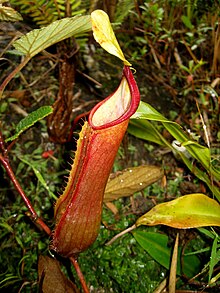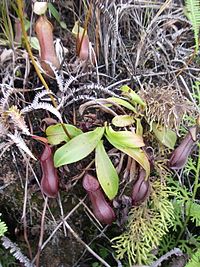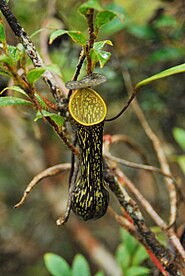東巴豬籠草
| 東巴豬籠草 | |
|---|---|

| |
| 東巴豬籠草的下位籠 | |
| 科學分類 | |
| 界: | 植物界 Plantae |
| 演化支: | 維管束植物 Tracheophyta |
| 演化支: | 被子植物 Angiosperms |
| 演化支: | 真雙子葉植物 Eudicots |
| 目: | 石竹目 Caryophyllales |
| 科: | 豬籠草科 Nepenthaceae |
| 屬: | 豬籠草屬 Nepenthes |
| 種: | 東巴豬籠草 N. tobaica
|
| 二名法 | |
| Nepenthes tobaica Danser (1928)
| |
| 異名 | |
| |
東巴豬籠草[1](學名:Nepenthes tobaica),又稱多巴豬籠草,是蘇門答臘特有的熱帶食蟲植物。[1]其因大量分佈於多巴湖附近而得名。
東巴豬籠草與昂嘎桑豬籠草(N. angasanensis)、小豬籠草(N. gracilis)、邁克豬籠草(N. mikei)和兩眼豬籠草(N. reinwardtiana)存在着密切的近緣關係。[2]
植物學史
[編輯]
1856年2月8日,約翰內斯·伊萊亞斯·特斯曼採集到了第一份東巴豬籠草標本,其可能採集自巴塔克地區。該標本包含雌性花序,編號為「H. L. B. 908,155-1106」。[3]
馬修·傑布和馬丁·奇克在他們1997年的專著《豬籠草屬(豬籠草科)的框架性修訂》中將上述標本指定為東巴豬籠草的選模標本。[4]
1928年,荷蘭植物學家B·H·丹瑟在其開創性的專著《荷屬東印度群島的豬籠草科植物》中正式描述[注 1]了東巴豬籠草。[3]在當時僅能從許多標本中認識到東巴豬籠草。[注 2]所以B·H·丹瑟認為其可能與兩眼豬籠草是同一個物種:[注 3][3]
| “ | 東巴豬籠草僅發現於多巴湖的北部、西部及南部高原。其與兩眼豬籠草存在着最為密切的近緣關係,同時我不敢肯定其是否是該物種的一個變型,但到現在為止也沒有發現中間型。 | ” |
在科學文獻中,東巴豬籠草曾多次的與昂嘎桑豬籠草相混淆。B·H·丹瑟在1940年對密花豬籠草(N. densiflora)的描述中所述的東巴豬籠草[5]實為昂嘎桑豬籠草。[2]在羅斯朱迪·塔明(Rusjdi Tamin)和堀田滿1986年關於蘇門答臘的豬籠草專著中被鑑定為東巴豬籠草的物種[6]實際上混合了昂嘎桑豬籠草和東巴豬籠草。[2]
在園藝貿易中許多以東巴豬籠草名稱銷售的植株很可能是印度豬籠草(N. khasiana)與葫蘆豬籠草(N. ventricosa)的雜交種。[7]
形態特徵
[編輯]
東巴豬籠草為藤本植物。莖可攀爬至7米的高處,直徑可達6毫米。節間距可長達25厘米,呈圓柱形。但成年植株的莖可因源於節點延伸至整個節間的凹槽而呈稜柱形。[2]
東巴豬籠草的葉片無柄至具小葉柄,革質,呈長圓形至匙形,可長達20厘米,寬至4厘米。葉尖通常為圓形,但也可能縮窄或鈍尖。茁壯植株的籠蔓與葉片的銜接處有時略呈盾形。葉片漸狹或驟縮至基部,包住莖周長的一半。中脈兩側各有1至3條縱脈,但僅於茁壯植株的標本上明顯。羽狀脈不明顯。籠蔓可長達30厘米。[2]

東巴豬籠草下位籠的下半部為卵形,上半部為圓柱形。其可高達20厘米,寬至4厘米。腹面具一對籠翼,其上半部或整體具翼須。下位籠卵形部分對應的內表面為腺體區。籠蓋基部下方的捕蟲籠內表面上偶爾會出現一對「眼點」。籠口為卵形,傾斜。唇較窄,僅可寬至5毫米,呈圓柱形或略展開,有明顯的唇齒。籠蓋為卵形至橢圓形,基部為心形。無附屬物。籠蓋基部的後方有一根可長達5毫米的籠蔓尾。其可能不分叉、二叉或三叉。[2]
東巴豬籠草上位籠的最下部通常為漏斗形,下三分之一為窄卵形,上部為圓柱形或略縮窄。其體型較下位籠大,高可達25厘米,寬可至5厘米。[2]內表面蠟質區極其發達。[8]腹面的籠翼縮小為一對隆起。[2]唇內緣部分約佔截面表面總長度的40%。[8]上位籠其餘形態特徵類似於下位籠。[2]
東巴豬籠草的花序為總狀花序。總花梗和花序軸都可長達20厘米。每一個花梗帶兩朵花,無苞片。雄性花序的萼片為橢圓形-鈍尖,雌雄花序的萼片略窄。[2]在不拉巴(Prapat)附近,4月可見到花序,但果實此時不常見。[9]
東巴豬籠草植株各部分的毛被發達程度不均。大部分成熟的營養組織都無毛,僅中脈可能具持久性的毛被。葉腋通常存在星狀的白色毛被。萼片披被着密集的絨毛,但花序其餘部分僅披被着稀疏的短毛被。[2]
某些變型籠蓋的下表面為鮮紅色,從而使其在周圍的植被中顯得特別的明顯。[9]
生態關係
[編輯]東巴豬籠草是蘇門答臘的特有種。其自然分佈範圍一度被認為北至亞齊省的加約地區(Gayo Lands),南至打鹿洞。20世紀末,在更靠南的地方發現了該物種新的分佈地。其包括索克·麥拉皮山(Mount Sorik Merapi)及占碑省葛林芝湖附近的高海拔泥炭沼澤。[2]查爾斯·克拉克根據實武牙附近低海拔原生地及潘丘盧保山的高海拔原生地得出其海拔分佈範圍為380至1800米。但依馬修·傑布和馬丁·奇克而言,東巴豬籠草可生長於海拔高達2750米的地區。[4][10]
東巴豬籠草多陸生於開闊的區域。[2]其通常生長於森林邊緣,一般與薄子木屬(Leptospermum)和桃金娘屬(Rhodomyrtus)植物同域分佈。[10]
多巴湖地區存在着大量的東巴豬籠草,[11]在這「很難不看到它」。[2]東巴豬籠草也生長於葛林芝湖附近高海拔的泥炭沼澤森林中,其海拔約1100米。在此,東巴豬籠草與蘋果豬籠草、小豬籠草、奇異豬籠草(N. mirabilis)、兩眼豬籠草和匙葉豬籠草(N. spathulata)混生。豬籠草的純種和自然雜交種在該地區表現出高度的漸滲。該地區的植被主要由杜鵑花屬(Rhododendron)和野牡丹屬(Melastoma)植物,以及蘭花與蕨類組成。其非常矮小、茂密,高度很少超過3米。與婆羅洲沙勞越巴廖附近的高地荒原森林有幾分相似。[2]
根據2000年的評估,東巴豬籠草已被列入《2006年世界自然保護聯盟瀕危物種紅色名錄》中,保護狀況為無危。[10]
尚未在蘇門答臘以外發現東巴豬籠草。[2]
底內生物
[編輯]東巴豬籠草的捕蟲籠中存在着多種底內生物。一種棲息於爪哇東巴豬籠草等豬籠草屬植物捕蟲籠中蟎類已被描述為「Creutzeria tobaica」。[12][13]
相關物種
[編輯]| 昂嘎桑豬籠草、邁克豬籠草和東巴豬籠草之間的形態特徵區別(Salmon & Maulder, 1999) | |||
| 形態特徵 | 昂嘎桑豬籠草 | 邁克豬籠草 | 東巴豬籠草 |
|---|---|---|---|
| 習性 | 有發自地下根莖的側枝 | 無根莖 | 無根莖 |
| 籠蔓尾 | 分叉狀 | 叢狀 | 絲狀 |
| 唇齒 | 長1.5至2毫米 | 長0.2至0.4毫米 | 短於0.2毫米 |
| 莖 | 圓柱形 | 圓柱形 | 圓柱形至鈍三稜柱形 |
| 苞片 | 僅偶爾出現於最底部的花梗基部附近 | 出現於所有花梗的中部 | 量少,出現於花梗基部或略基部處 |
| 捕蟲籠腺體 | 300 / cm² | 150-180 / cm² | 200-250 / cm² |
| 花梗花數 | 1朵 | 1朵 | 2朵 |
| 雌性花序 | 55至125毫米;9至17朵花 | 40至80毫米;4至10朵花 | 195至400毫米;30至50朵花 |
2001年,查爾斯·克拉克對來自蘇門答臘島和西馬來西亞的豬籠草進行了分支系統學分析,共利用了70個形態特徵。以下為豬籠草進化樹的「第6分支」。[2]
| ||||||||||||||||||||||||||||
東巴豬籠草的捕蟲籠與寬葉豬籠草很相似,但莖和葉片的差別較大。[2]
昂嘎桑豬籠草、血紅豬籠草(N. sanguinea)、窄葉豬籠草(N. stenophylla)和毛蓋豬籠草(N. tentaculata)的捕蟲籠內表面上都曾發現過「眼點」。[2][14]但這些物種大部分極少出現眼點或僅出現於個別捕蟲籠中。[14]但產自多巴湖南部的東巴豬籠草(特別是產自索克·麥拉皮山和實武牙至打鹿洞)常常出現眼點。[2]
自然雜交種
[編輯]已發現了東巴豬籠草與蘋果豬籠草、兩眼豬籠草、菱莖豬籠草、匙葉豬籠草和顯目豬籠草(N. spectabilis)的自然雜交種。[2][15][16]
註釋
[編輯]- ^ B·H·丹瑟專著中東巴豬籠草原拉丁文描述:[3]
“ Folia mediocria sessilia, lamina lineari-lanceolata, nervis longitudinalibus utrinque 0-1, raro 2, basi lata semiamplexicauli ; ascidia rosularum ignota ; ascidia inferiora parte inferiore anguste ovata, medio angustata, os versus infundibuliformia, alis 2 fimbriatis, peristomio operculum versus acuto, cylindrico, 1/2-1 mm lato, costis 1/3-1/4 mm distantibus, saepe indistinctis, dentibus fere 0 ; operculo rotundato-elliptico, facie inferiore plano ; ascidia superiora parva, e basi infundibuliformi parte inferiore paulum ventricosa, medio leviter angustata, os versus paulum infundibuliformia, costis 2 prominentibus, peristomio operculum versus acuto, cylindrico, 1/2-1 mm lato, costis 1/3-1/4 mm distantibus, saepe indistinctis, dentibus fere 0 ; operculo orbiculari v. rotundato-elliptico facie interiore plana ; inflorescentia racemus pedicellis 13-15 mm longis fere omnibus 2-floris ; indumentum in inflorescentiis et ascidiis parcum stellatum, ceterum 0. ” - ^ 除了羅斯朱迪·塔明1856採集的標本外,丹瑟還列出了11份獨立的東巴豬籠草標本。依照時間順序,如下:
Gov. Eastcoast:
- G. Sibajak, 1300 m, 27 I 1923, LÖRZING 9443, H. B. (0) ;
- Karo Plateau, on the East-Siosar, 1450-1550 m, 12 XI 1921, LÖRZING 6802, H. B. (m, f), H. L. B. (m.f) ;
- between Midan and Berastagi, Lau-deboek-deboek, 20 VI 1926, BOEDIJN, H. D. 6408, H. B. (0) ;
- Berastagi, 1350 m, 12 III 1926, YATES 2013 H. U. C. (m), H. B. (m) ;
- near Perapat, rocky coast of Lake Toba, 910 m, 11 X 1920, LÖRZING & JOCHEMS, H. D.P. 7612, H. B. (0) ;
- Haranggoal, near Lake Toba, 1200 m, IV 1927, BEUMÉE A 438, H. B. (0) ;
- at the way between Perapat and Pematang Siantar, 1000 m, IV 1927, BEUMÉE A 448, H. B. (0) ;
Res. Tapiannoeli:
- on the Sg. Asahan near Lake Toba, 950-1050 m. LÖRZING 9889, H. B. (f) ;
- Plateau of Habinsaran, E.S.E. of Lake Toba, 1200-1300 m, 11 V 1919, LÖRZING 6573, H. B. (m, f), H. L. B. (f), also on alcohol, type ;
- about 25 km S.E. of Baligé, 1300 m. 11 XII 1918, RUTGERS & VAN HEURN 1, H. B. (f), H. L. B. (f) ;
- Benandolok, 1000 m, OUWEHAND 79, H. B. (f) ;
- TEYSMANN, probably Batak regions, 8 II 1856, H. L. B. 908,155-1106 (f).
- ^ B·H·丹瑟對東巴豬籠草與兩眼豬籠草之間的論述原文:[3]
“ N. tobaica has only been found on the plateau north, east and south of Lake Toba. It is most closely related to N. Reinwardtiana and I am not quite certain, whether it is perhaps a form of this species, but up till now no intermediate forms have been discovered. ”
參考文獻
[編輯]- ^ 1.0 1.1 1.2 夏洛特. 食蟲植物觀賞&栽培圖鑑. 台北: 商周出版. 2007: 78. ISBN 978-986-124-850-9.
- ^ 2.00 2.01 2.02 2.03 2.04 2.05 2.06 2.07 2.08 2.09 2.10 2.11 2.12 2.13 2.14 2.15 2.16 2.17 2.18 2.19 2.20 Clarke, C.M. 2001. Nepenthes of Sumatra and Peninsular Malaysia. Natural History Publications (Borneo), Kota Kinabalu.
- ^ 3.0 3.1 3.2 3.3 3.4 Danser, B.H. 1928. 45. Nepenthes tobaica DANS., spec. nova. (頁面存檔備份,存於互聯網檔案館). In: The Nepenthaceae of the Netherlands Indies. Bulletin du Jardin Botanique de Buitenzorg, Série III, 9(3–4): 249–438.
- ^ 4.0 4.1 Jebb, M.H.P. & M.R. Cheek 1997. A skeletal revision of Nepenthes (Nepenthaceae). Blumea 42(1): 1–106.
- ^ Danser, B.H. 1940. A new Nepenthes from Sumatra. Bulletin du Jardin Botanique de Buitenzorg, Série III, 16: 268–271.
- ^ Tamin, R. & M. Hotta 1986. Nepenthes di Sumatera: The genus Nepenthes of the Sumatra Island. In: M. Hotta (ed.) Diversity and Dynamics of Plant Life in Sumatra 1. Kyoto University, JapaN. pp. 75–109.
- ^ Catalano, M. 2009. Nepenthes. In: Growing Carnivores — an Italian perspective. Prague. pp. 50–57.
- ^ 8.0 8.1 Bauer, U., C.J. Clemente, T. Renner & W. Federle 2012. Form follows function: morphological diversification and alternative trapping strategies in carnivorous Nepenthes pitcher plants. Journal of Evolutionary Biology 25(1): 90–102. doi:10.1111/j.1420-9101.2011.02406.x
- ^ 9.0 9.1 Shivas, R.G. 1984. The Lake Toba Nepenthes.PDF Carnivorous Plant Newsletter 13(1): 15–16.
- ^ 10.0 10.1 10.2 Clarke, C.M., R. Cantley, J. Nerz, H. Rischer & A. Witsuba. Nepenthes tobaica. The IUCN Red List of Threatened Species 2000. [12 May 2006].
- ^ Russell, G. 1985. Sumatran Expedition January 1985.PDF Carnivorous Plant Newsletter 14(4): 97–101.
- ^ Oudemans, A.C. 1932. Opus 550. Tijdschrift voor Entomologie 75: 202–210.
- ^ Fashing, N.J. 2002. Nepenthacarus, a new genus of Histiostomatidae (Acari: Astigmata) inhabiting the pitchers of Nepenthes mirabilis (Lour.) Druce in Far North Queensland, Australia.PDF (1.64 MiB) Australian Journal of Entomology 41(1): 7–17. doi:10.1046/j.1440-6055.2002.00263.x
- ^ 14.0 14.1 Clarke, C.M. 1997. Nepenthes of Borneo. Natural History Publications (Borneo), Kota Kinabalu.
- ^ McPherson, S.R. 2009. Pitcher Plants of the Old World. 2 volumes. Redfern Natural History Productions, Poole.
- ^ (印尼文) Dariana 2010. Keanekaragaman Nepenthes dan pohon inang di Taman Wisata Alam Sicikeh-Cikeh Kabupaten Dairi Sumatera Utara (頁面存檔備份,存於互聯網檔案館). M.Sc. thesis, University of North Sumatra, Medan.
- (印尼文) Akhriadi, P. 2007. Kajian taksonomi hibrid alami Nepenthes (Nepenthaceae) di Kerinci. Working paper, Andalas University, Padang. Abstract
- Bonhomme, V., H. Pelloux-Prayer, E. Jousselin, Y. Forterre, J.-J. Labat & L. Gaume 2011. Slippery or sticky? Functional diversity in the trapping strategy of Nepenthes carnivorous plants. New Phytologist, published online on March 24, 2011. doi:10.1111/j.1469-8137.2011.03696.x
- Hernawati & P. Akhriadi 2006. A Field Guide to the Nepenthes of Sumatra. PILI-NGO Movement, Bogor.
- Hopkins, M., R. Maulder & B.[R.] Salmon 1990. A real nice trip to Southeast Asia.PDF (1.72 MiB) Carnivorous Plant Newsletter 19(1–2): 19–28.
- Kitching, R.L. 2000. Food Webs and Container Habitats: The natural history and ecology of phytotelmata(頁面存檔備份,存於互聯網檔案館). Cambridge University Press, Cambridge.
- (印尼文) Mansur, M. 2001. Koleksi Nepenthes di Herbarium Bogoriense: prospeknya sebagai tanaman hias.PDF In: Prosiding Seminar Hari Cinta Puspa dan Satwa Nasional. Lembaga Ilmu Pengetahuan Indonesia, Bogor. pp. 244–253.
- McPherson, S.R. & A. Robinson 2012. Field Guide to the Pitcher Plants of Sumatra and Java. Redfern Natural History Productions, Poole.
- Meimberg, H., A. Wistuba, P. Dittrich & G. Heubl 2001. Molecular phylogeny of Nepenthaceae based on cladistic analysis of plastid trnK intron sequence data. Plant Biology 3(2): 164–175. doi:10.1055/s-2001-12897
- (德文) Meimberg, H. 2002. Molekular-systematische Untersuchungen an den Familien Nepenthaceae und Ancistrocladaceae sowie verwandter Taxa aus der Unterklasse Caryophyllidae s. l..PDF Ph.D. thesis, Ludwig Maximilian University of Munich, Munich.
- Meimberg, H. & G. Heubl 2006. Introduction of a nuclear marker for phylogenetic analysis of Nepenthaceae. Plant Biology 8(6): 831–840. doi:10.1055/s-2006-924676
- Meimberg, H., S. Thalhammer, A. Brachmann & G. Heubl 2006. Comparative analysis of a translocated copy of the trnK intron in carnivorous family Nepenthaceae. Molecular Phylogenetics and Evolution 39(2): 478–490. doi:10.1016/j.ympev.2005.11.023
- Renner, T. & C.D. Specht 2011. A sticky situation: assessing adaptations for plant carnivory in the Caryophyllales by means of stochastic character mapping. International Journal of Plant Sciences 172(7): 889–901. doi:10.1086/660882
- Salmon, B. & R. Maulder 1999. Notes on Nepenthes from Northern Sumatra.(頁面存檔備份,存於互聯網檔案館) Carnivorous Plant Newsletter 28(1): 14-18.
- Thornhill, A.H., I.S. Harper & N.D. Hallam 2008. The development of the digestive glands and enzymes in the pitchers of three Nepenthes species: N. alata, N. tobaica, and N. ventricosa (Nepenthaceae). International Journal of Plant Sciences 169(5): 615–624. doi:10.1086/533599







